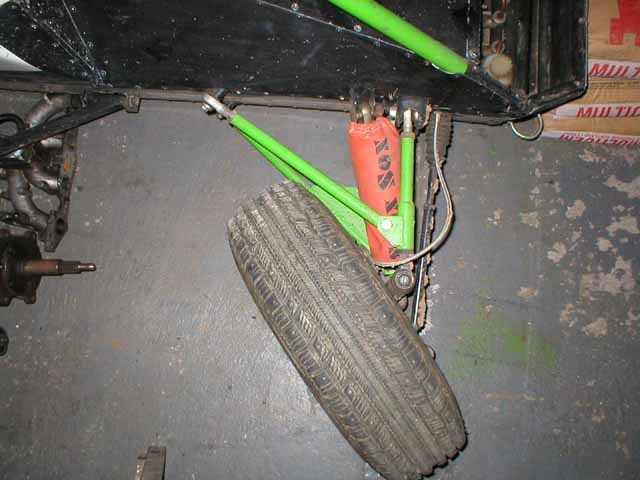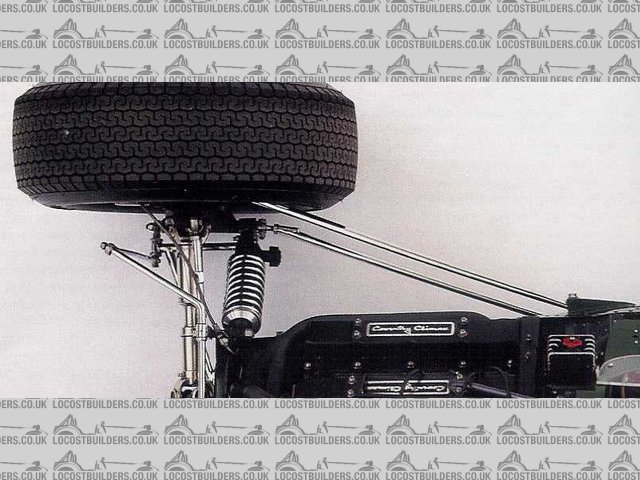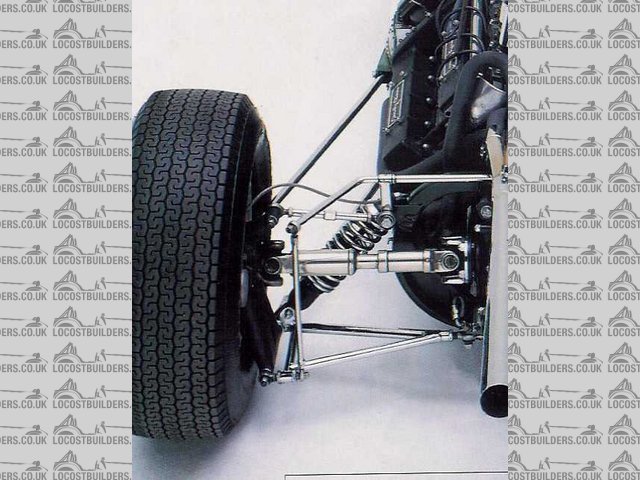Jon Ison
|
 posted on 25/1/06 at 08:16 PM posted on 25/1/06 at 08:16 PM |

|
|
What would happen if ?
Imagine the poor pic below is a upper rear wishbone, what would happen if a 3rd leg as shown in red was added ? Would it add strength and stability
too the top of the upright or is it a definite no no don't go there ?
|
|
|
|
|
Mark Allanson
|
| posted on 25/1/06 at 08:35 PM |

|
|
Would certainly share the loads over a much larger area of the top rail. The only downside I can see is the space issue, may increase the wheelbase a
little.
If you can keep you head, whilst all others around you are losing theirs, you are not fully aware of the situation
|
|
|
JoelP
|
| posted on 25/1/06 at 08:37 PM |

|
|
you would have to be careful to ensure that all three pivot points were in line. If it were mine, id drop the middle leg out of it though, and use
rosejoints to ensure the two pivots lined up. You'd also have to make sure that the chassis was braced well in the new pickup point.
|
|
|
cymtriks
|
| posted on 25/1/06 at 08:40 PM |

|
|
Do you mean adding or replacing?
If you add a third leg then the wisbone bushes will fight each other, you will never get them perfectly aligned.
If you replace the wishbone with a wider one, i.e. by replacing one of the legs with a new one that creates a much wider design, then that should be
better.
Having said that why do think that your top wishbone needs stabilising?
|
|
|
Jon Ison
|
| posted on 25/1/06 at 09:26 PM |

|
|
By stabilising (bad choice of word) what i mean really is add strength under acceleration and braking, prob still bad choice of word.
|
|
|
JoelP
|
| posted on 25/1/06 at 09:40 PM |

|
|
as i see it, rear wishbones will see more force from acceleration than braking, hence why i believe it a good idea to spread the legs a bit.
Admittedly the front leg is in compression, but it would be anyway. Having them further apart puts less stress on the chassis (imagine if the legs
were only a few inches apart, it would bend the brackets off).
|
|
|
ned
|
| posted on 25/1/06 at 10:33 PM |

|
|
As long as the bushes were in line ie the pivot points were inline it'd be fine. It would add strength to teh wishbone.
an alternative would be to have to rose jointed at either end and have it like a tie rod or drag link. a friends sports 2000 lola has a similar
setup.
Ned.
beware, I've got yellow skin
|
|
|
locost_bryan
|
| posted on 26/1/06 at 02:47 AM |

|
|
quote:
Originally posted by ned
an alternative would be to have to rose jointed at either end and have it like a tie rod or drag link. a friends sports 2000 lola has a similar
setup.
That was the standard setup for F1 cars in the '70s - a transverse link from the gearbox and a semi-trailing radius rod from the front of the
engine to create in effect a wide-based wishbone.
Bryan Miller
Auckland NZ
Bruce McLaren - "Where's my F1 car?"
John Cooper - "In that rack of tubes, son"
|
|
|
britishtrident
|
| posted on 26/1/06 at 07:29 AM |

|
|
Not a good idea a wishbone should have 2 legs, introducing a redundant 3rd leg brings in all sorts of alignment problems.
[Edited on 26/1/06 by britishtrident]
|
|
|
NS Dev
|
| posted on 26/1/06 at 08:31 AM |

|
|
Wide based wishbone...............
 
grassersteer1
Retro RWD is the way forward...........automotive fabrication, car restoration, sheetmetal work, engine conversion
retro car restoration and tuning
|
|
|
Marcus
|
| posted on 26/1/06 at 09:09 PM |

|
|
I'm with Ned on this one, a rose joint at each end makes the third link floating, alleviating any alignment issues - bit like a drag link or
compression strut as used on many a rally car.
Marcus
Marcus
Because kits are for girls!!
|
|
|
Mark Allanson
|
| posted on 26/1/06 at 10:05 PM |

|
|
Its not just the upper wishbone strength, its the spreading of the load so you can make the chassis lighter
If you can keep you head, whilst all others around you are losing theirs, you are not fully aware of the situation
|
|
|
zilspeed
|
| posted on 26/1/06 at 10:14 PM |

|
|
As has been already said - the semi trailing link like that is very like 70s 80s single seater thinking.
Nothing much wrong with that.
|
|
|
britishtrident
|
| posted on 27/1/06 at 05:03 PM |

|
|
Trailing link -- reversed wishbone type Chapman at his best so simple so light. The toe in under roll helped reduce the oversteer found in Lotus
single seaters of this era -- they used the same tyre size front and rear.
[Edited on 27/1/06 by britishtrident]
 
Rescued attachment tr2.jpg
|
|
|
britishtrident
|
| posted on 27/1/06 at 05:07 PM |

|
|
same again
This type gives some toe-in on roll -- substituting to parrallel links for the lower reversed wishbone removes this.
[Edited on 27/1/06 by britishtrident]
 
Rescued attachment trla2.jpg
|
|
|
britishtrident
|
| posted on 27/1/06 at 05:15 PM |

|
|
Using 3 pivots is - REALLY BAD KARMA ---- If you get the pivots line up static -- they won't line up under load remember the whole structure
both of the car and he wishbone deforms underload, you could get round this by using rod ends at each end and a soft bush in the middle but why ---
this makes the leg in the middle is redundant it is doing sweet fa so why have it.
The third problem is very familiar to to bridge designers -- if you a have more than two reastraints/supports how do work out where the loads are
going.
Trailing link designs; there are a couple variations one which uses parrallel links the other uses reversed lower wishbone are OK and were
only replace by rear wishbones in F1 to make room for the aerodynamics.
Wide based wishbones - Ron Taurnac used wide based wishones to great effect in F1, and Eric Broadley was also a fan --- are like NSDEVS --- also
look at the (real BMC ) Mini lower wishbone.
[Edited on 27/1/06 by britishtrident]
|
|
|













